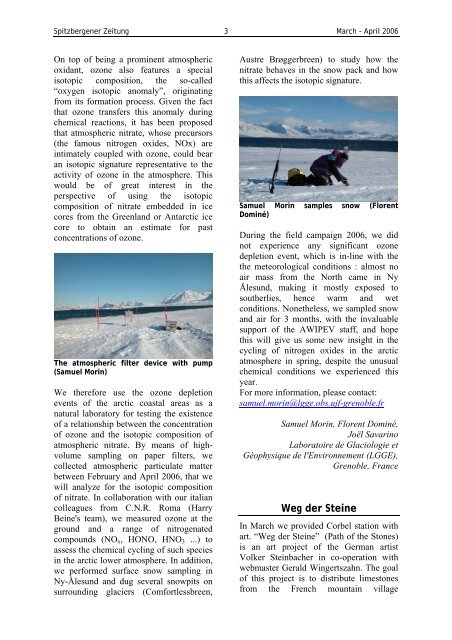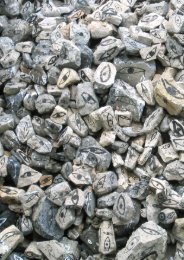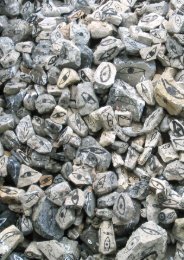Welt Auge - Volker Steinbacher
Welt Auge - Volker Steinbacher
Welt Auge - Volker Steinbacher
Sie wollen auch ein ePaper? Erhöhen Sie die Reichweite Ihrer Titel.
YUMPU macht aus Druck-PDFs automatisch weboptimierte ePaper, die Google liebt.
Spitzbergener Zeitung 3 March - April 2006<br />
On top of being a prominent atmospheric<br />
oxidant, ozone also features a special<br />
isotopic composition, the so-called<br />
“oxygen isotopic anomaly”, originating<br />
from its formation process. Given the fact<br />
that ozone transfers this anomaly during<br />
chemical reactions, it has been proposed<br />
that atmospheric nitrate, whose precursors<br />
(the famous nitrogen oxides, NOx) are<br />
intimately coupled with ozone, could bear<br />
an isotopic signature representative to the<br />
activity of ozone in the atmosphere. This<br />
would be of great interest in the<br />
perspective of using the isotopic<br />
composition of nitrate embedded in ice<br />
cores from the Greenland or Antarctic ice<br />
core to obtain an estimate for past<br />
concentrations of ozone.<br />
The atmospheric filter device with pump<br />
(Samuel Morin)<br />
We therefore use the ozone depletion<br />
events of the arctic coastal areas as a<br />
natural laboratory for testing the existence<br />
of a relationship between the concentration<br />
of ozone and the isotopic composition of<br />
atmospheric nitrate. By means of highvolume<br />
sampling on paper filters, we<br />
collected atmospheric particulate matter<br />
between February and April 2006, that we<br />
will analyze for the isotopic composition<br />
of nitrate. In collaboration with our italian<br />
colleagues from C.N.R. Roma (Harry<br />
Beine's team), we measured ozone at the<br />
ground and a range of nitrogenated<br />
compounds (NOx, HONO, HNO3 ...) to<br />
assess the chemical cycling of such species<br />
in the arctic lower atmosphere. In addition,<br />
we performed surface snow sampling in<br />
Ny-Ålesund and dug several snowpits on<br />
surrounding glaciers (Comfortlessbreen,<br />
Austre Brøggerbreen) to study how the<br />
nitrate behaves in the snow pack and how<br />
this affects the isotopic signature.<br />
Samuel Morin samples snow (Florent<br />
Dominé)<br />
During the field campaign 2006, we did<br />
not experience any significant ozone<br />
depletion event, which is in-line with the<br />
the meteorological conditions : almost no<br />
air mass from the North came in Ny<br />
Ålesund, making it mostly exposed to<br />
southerlies, hence warm and wet<br />
conditions. Nonetheless, we sampled snow<br />
and air for 3 months, with the invaluable<br />
support of the AWIPEV staff, and hope<br />
this will give us some new insight in the<br />
cycling of nitrogen oxides in the arctic<br />
atmosphere in spring, despite the unusual<br />
chemical conditions we experienced this<br />
year.<br />
For more information, please contact:<br />
samuel.morin@lgge.obs.ujf-grenoble.fr<br />
Samuel Morin, Florent Dominé,<br />
Joël Savarino<br />
Laboratoire de Glaciologie et<br />
Géophysique de l'Environnement (LGGE),<br />
Grenoble, France<br />
Weg der Steine<br />
In March we provided Corbel station with<br />
art. “Weg der Steine” (Path of the Stones)<br />
is an art project of the German artist<br />
<strong>Volker</strong> <strong>Steinbacher</strong> in co-operation with<br />
webmaster Gerald Wingertszahn. The goal<br />
of this project is to distribute limestones<br />
from the French mountain village






